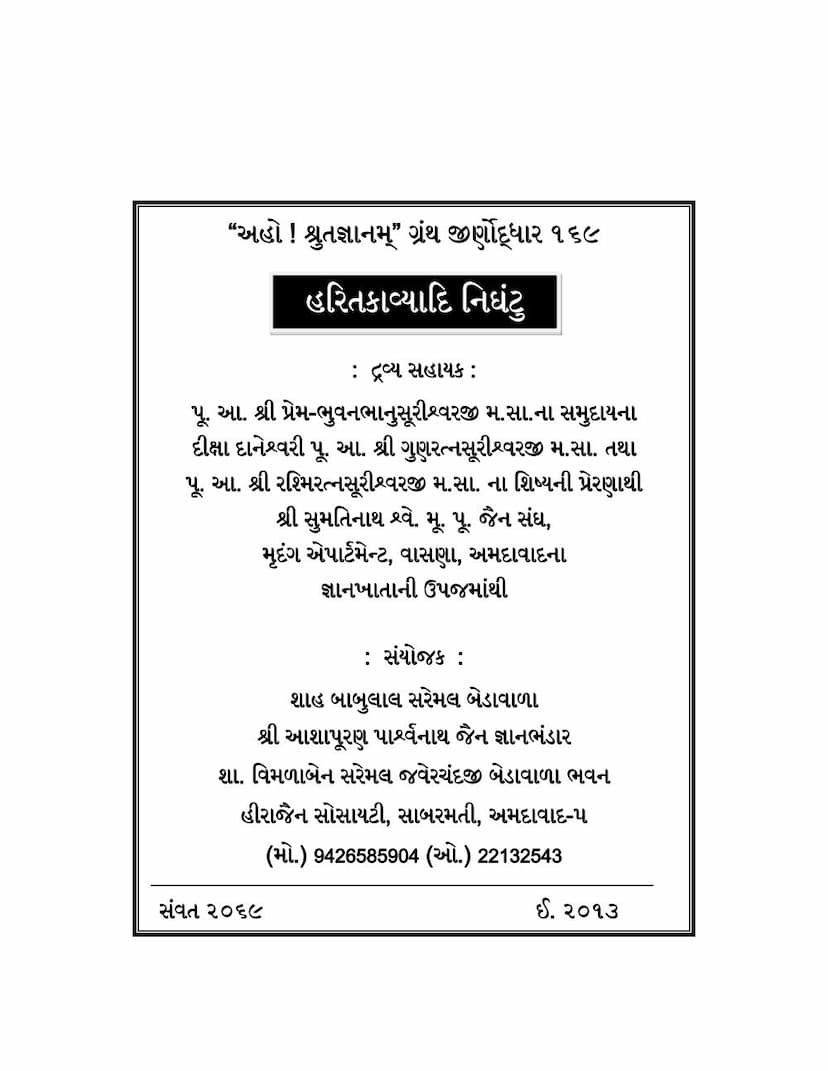Harit Kavyadi Nighantu
Added to library: September 1, 2025

Summary
The provided text is a detailed index and commentary on the Haritakyadi Nighantu, a part of Bhavaprakasha, compiled by Bhav Mishra and commented upon by Shiv Sharma, with the commentary named Shiv Prakashika. The publisher is Khemraj Shrikrishnadas, Mumbai. The book is a comprehensive Ayurvedic lexicon that lists and describes various medicinal plants, minerals, animal products, and food items, along with their properties, uses, and synonyms.
Here's a breakdown of the key aspects based on the provided pages:
Book Title: Haritakyadi Nighantu (part of Bhavaprakasha) Author: Bhav Mishra Commentary/Translation: Shiv Sharma (commentary named Shiv Prakashika) Publisher: Khemraj Shrikrishnadas, Mumbai Content: An Ayurvedic glossary (Nighantu) detailing the properties and classifications of numerous substances used in Ayurveda.
Key Features and Content:
-
Comprehensive Indexing: The text is meticulously organized into various chapters (Vargas) based on the type of substance. These include:
- Haritakyadi Varga: Deals with Amla, Haritaki, Bibhitaki, Triphala, and various other medicinal plants and their parts (roots, leaves, fruits, etc.). It starts with the origin and classification of Haritaki (Harad), detailing its different varieties, properties, and uses.
- Karpuraadi Varga: Covers aromatic substances like Karpura (Camphor), Kasturi (Musk), Chandana (Sandalwood) and their varieties.
- Guduchyaadi Varga: Focuses on Guduchi (Giloy) and its properties, along with other plants.
- Pushpa Varga: Details various flowers used in Ayurveda, such as Kamala (Lotus), Padmini, Mallika (Jasmine), Rose, Chandana, etc.
- Phala Varga: Encompasses fruits like Mango, Jambhul, Tamarind, Pomegranate, Banana, Coconut, Melon, etc., describing their properties and uses in different stages of ripeness.
- Vataadi Varga: Covers various trees and plants like Vata (Banyan), Ashwattha (Peepal), Shami, Sirisha, Khadira, etc., and their medicinal parts.
- Dhatu Varga: Discusses metals and minerals like Swarna (Gold), Rajata (Silver), Tamra (Copper), Vanga (Tin), Yashada (Zinc), Seesa (Lead), Loha (Iron), Parad (Mercury), Gandhak (Sulphur), Hartal (Orpiment), Manashila (Realgar), etc., their purification, properties, and therapeutic uses. It also delves into the classification and qualities of precious stones (Ratnas) and their substitutes (Updhatus), as well as various poisons (Vishas).
- Dhanya Varga: Details various types of grains like Shali (rice varieties), Vrihi, Yava (barley), Godhuma (wheat), Mudga (mung beans), Masha (urad beans), etc., and their properties.
- Shaka Varga: Covers various types of leafy vegetables and other edible greens like Vastuka, Palak, Patola, etc., and their medicinal properties, with a general caution about excessive consumption of vegetables and sour foods.
- Vari Varga: Discusses water sources and their qualities, categorizing water based on origin (divine, earthly), season, and collection methods, highlighting the importance of processed water.
- Dugdha Varga: Encompasses milk from various animals (cow, buffalo, goat, sheep, horse, camel, elephant, human) and their properties, emphasizing cow's milk as superior. It also details milk derivatives like Piyusha (colostrum), Kinata (condensed milk), Ksheerashaka, etc.
- Dadhee Varga: Describes curd and its varieties, properties, and therapeutic uses, along with the associated benefits and contraindications.
- Takra Varga: Focuses on buttermilk and its different types and medicinal benefits.
- Navanita Varga: Deals with butter and its properties.
- Ghrita Varga: Covers ghee (clarified butter) from various sources, its processing, and extensive medicinal uses, emphasizing aged ghee.
- Mutra Varga: Discusses various animal urines and their medicinal properties, with cow's urine being highlighted.
- Taila Varga: Details various oils derived from seeds and plants like sesame, mustard, castor, linseed, etc., and their therapeutic applications.
- Madhu Varga: Covers honey and its different varieties (Maakshika, Bhramara, Kshaudra, etc.), their properties, and uses.
- Ikshu Varga: Encompasses sugarcane and its products like Jaggery (Guda), Sugar (Sharkara), and their variations, describing their processing and effects.
- Sandhana Varga: Discusses fermented preparations like Kanji, Asavas, and Arishtas.
- Dravya Pariksha: Provides guidelines for testing the quality and authenticity of various substances, along with their substitutes when originals are unavailable.
- Samanya Paribhasha: General principles and definitions in Ayurveda.
- Maamsa Varga: Details the properties of meat from various animals (game, aquatic, domesticated) and birds, including their classifications and therapeutic uses.
- Krutaanna Varga: Covers cooked food preparations like rice, dals, khichdi, sweets, and their properties.
- Parishishta Namani: An appendix listing Sanskrit names with their vernacular (Bhasha) equivalents.
-
Medicinal Properties: The primary focus is on the therapeutic properties of each substance, including their taste (Rasa), potency (Virya), post-digestive effect (Vipaka), effect on doshas (Vata, Pitta, Kapha), toxicity, and their use in treating specific diseases.
-
Synonyms: The text provides numerous Sanskrit synonyms for each substance, which is crucial for understanding older texts and diverse regional nomenclature.
-
Origin and Description: For many plants and substances, the text provides details about their origin, physical characteristics, and identification.
-
Commentary (Shiv Prakashika): Shiv Sharma's commentary provides detailed explanations, elaborates on the original text, and offers practical insights, often including the vernacular names of the substances, making the complex Ayurvedic knowledge accessible.
-
Dedication and Preface: The work is dedicated to Vaidya Ratna Pandit Ram Prasad, the author's father. The preface by Shiv Sharma highlights the importance of commentaries for students and addresses potential criticisms regarding the necessity of another work in the field. It also emphasizes the author's endeavor to simplify complex points and provide accurate translations.
-
Aho! Shrutgyanam: This phrase appears on multiple pages, likely signifying a sentiment of reverence for knowledge or perhaps a recurring chant or blessing associated with the publication or the Jain educational initiative.
Overall Significance:
The Haritakyadi Nighantu as presented with the Shiv Prakashika commentary is a valuable resource for Ayurvedic scholars, practitioners, and students. It serves as a foundational text for understanding the materia medica of Ayurveda, offering a systematic approach to learning about thousands of substances and their applications. The detailed classification, synonyms, and descriptions make it a crucial reference for anyone studying or practicing Ayurveda, particularly within the Jain tradition which values extensive knowledge. The compilation and digitization efforts mentioned in the introductory pages (e.g., "Aho Shrutgyanam Granth Jirnyauddhar") highlight its role in preserving and disseminating rare and ancient texts.